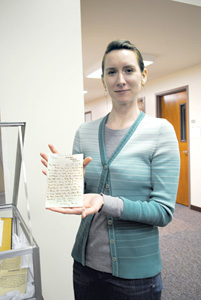Editorial
Front Page - Friday, March 19, 2010
Small slices of history reside in the new exhibit at Lupton Library
Erica Tuggle
 Chapel Cowden, of the Special Collections department, holds up a letter from Sir Arthur Conan Doyle, the author of “Sherlock Holmes.” This letter is among the items on display in the exhibit, “Our Cabinets of Antiquarian Curiosities,” running until June.
- Erica Tuggle
Chapel Cowden, of the Special Collections department, holds up a letter from Sir Arthur Conan Doyle, the author of “Sherlock Holmes.” This letter is among the items on display in the exhibit, “Our Cabinets of Antiquarian Curiosities,” running until June.
- Erica Tuggle
A letter from Mahatma Gandhi lies only a few feet away from a 1632 printing of William Shakespeare’s play “The Twelfth Night,” and beside that is a letter from Sir Arthur Conan Doyle, the writer of “Sherlock Holmes.” All these rare and historically robust items lay in full view at the University of Tennessee at Chattanooga’s new Special Collections exhibit entitled, “Our Cabinets of Antiquarian Curiosities,” on display until June 1.
The Special Collections department, housed on the second floor of Lupton Library, has been amassing these treasures since the school’s beginning in the 1880s, and has since accumulated a total of 110 cataloged collections in categories of religion, art, Civil War relics and more.
Steve Cox, the librarian of the Special Collections department, says the size of these collections can range from a single folder to seven or eight boxes full of material on a subject.
“What is unique about the collection on display now is that it is a sampling of what we have with no real themed focus,” Cox says. “We have some political photographs from the Associated Press White House photographer and Chattanooga Native, John Rous. Also, we have some odds and ends like a letter from Ghandi that was written to the university in 1931.”
One of the glass cases in the exhibit is dedicated to the works of notable author and illustrator, and UTC alumnus, Barry Moser. Moser attended the university in the 1960’s, and has donated many of his works after he heard the university was collecting items of his work.
In the exhibit, the Penny-royal Caxton Edition of the Holy Bible, illustrated exclusively by Moser, is on display. It is one of the only Bibles published in the 20th century to be illustrated by a single person. The department also has a special edition of the Bible; a 10,000 dollar copy bound in vellum and donated by Moser in memory of Dr. George Cress, a Guerry Professor Emeritus of Art when Moser attended the university.
“We have over 400 Barry Moser items; possibly one of the largest collections around,” Cox says.
Included in the exhibit are items from one of the largest collections documenting the serpent handling tradition in some of the churches in the Appalachian region. Cox says one of the most fascinating elements of this collection is a series of DVDs of services in which serpents are handled, the members drink strychnine and handle fire.
The Special Collections department is designed to house these items in a controlled environment where they are safe, secure and access is controlled Cox says.
“We want these items to be around hundreds of more years, but if we put these things on the shelf and let students handle them all the time, they wouldn’t last that long.”
He says it is important, especially for matters of local history, that these items are preserved for researches of the future.
Cox says the first six years he worked for special collections, he was opening up boxes and finding new things every day that no one knew existed in the collection.
“Many would be fascinated to come in here and really sink their teeth into some of things we have. There is no telling what they would discover,” Cox said.
Chapel Cowden, who also works in the Special Collections department, says, “This exhibit is just one way we are trying to reel people in, as well as Facebook and our blog, where we highlight oddities and items of interest from the collections.”
Cowden says the Barry Moser collection is her favorite, especially the woodblocks he hand carved to make his prints with.
Cox says, “A book bound in 1869, written by the father of Robert E. Lee, titled ‘Memoirs of the War’ with a biography of the author by his son, is one of my favorites. What makes it really special is that this was Robert E. Lee’s personal copy, and he wrote his name in the front of the book.”
The materials in the special collections are available to anyone; including students, faculty, the community and history-lovers abroad. Cox says anyone can come in and stay for as long as they please; looking over materials they are interested in.
He hopes the new exhibit will peak interest for people to come in and learn new things. Looking through one of the university’s “Moccasin” yearbooks, Coxs says he found out that Hugh Beaumont, who played Ward Cleaver in the “Leave it to Beaver” television program, attended and played football for the University of Chattanooga for one year.
Cox says, “Everything we have is important and good, but these are really nice things that people don’t know about.”
He also says rumors that they have books bound in human skin are false.
To read more about the Special Collections, visit http://blog.lib/utc .edu/archivist/.
|
|